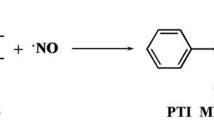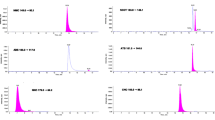Abstract
Aldehydes are abundantly present in tobacco smoke and in urban air pollution and are endogenously generated as products of the lipid peroxidation process. These molecules can react with DNA bases forming mutagenic exocyclic adducts, which have been used as biomarkers of aldehyde exposure and as potential tools for the study of inflammation, metal storage diseases, neurodegenerative disorders, and cancer. High-performance liquid chromatography-tandem mass spectrometry (HPLC/MS/MS) provides a highly precise, specific and ultrasensitive method for the detection of exocyclic DNA adducts. Here we present and describe a validated micro-HPLC-Electro Spray Ionization (ESI)-MS/MS method for the quantification of 1,N2-propanodGuo, an adduct produced following the reaction between 2′-deoxyguanosine and acetaldehyde or crotonaldehyde.
Access this chapter
Tax calculation will be finalised at checkout
Purchases are for personal use only
Similar content being viewed by others
References
Sanchez AB, Garcia CCM, Freitas FP et al (2018) DNA adduct formation in the lungs and brain of rats exposed to low concentrations of [13C2]-acetaldehyde. Chem Res Toxicol 18:332–339
Stein S, Lao Y, Yang IY et al (2006) Genotoxicity of acetaldehyde- and crotonaldehyde-induced 1,N2-propanodeoxyguanosine DNA adducts in human cells. Mutat Res Genet Toxicol Environ Mutagen 608:1–−7
Hecht SS, McIntee EJ, Wang MY (2001) New DNA adducts of crotonaldehyde and acetaldehyde. Toxicology 166:31–36
Lachenmeier DW, Sohnius EM (2008) The role of acetaldehyde outside ethanol metabolism in the carcinogenicity of alcoholic beverages: evidence from a large chemical survey. Food Chem Toxicol 46:2903–2911
Woutersen RA, Appelman LM, Van Der Heijde CA (1984) Inhalation toxicity of acetaldehyde in rats II. Carcinogenicity study: interim results after 15 months. Toxicology 31:123–133
Visapaa JP, Gotte K, Benesova M et al (2004) Increased cancer risk in heavy drinkers with the alcohol dehydrogenase 1C*1 allele, possibly due to salivary acetaldehyde. Gut 53:871–876
International Agency for Research on Cancer, Lyon, France (1999) Monographs on the Evaluation of the Carcinogenic Risk of Chemicals to Humans 71: 319–335
Matsuda T, Yabushita H, Kanaly RA et al (2006) Increased DNA damage in ALDH2-deficient alcoholics. Chem Res Toxicol 19:1374–1378
Garcia CCM, Angeli JPF, Freitas FP et al (2011) J Am Chem Soc 133(24):9140–9143. https://doi.org/10.1021/ja2004686
Wang M, Nishikawa A, Chung FL (1992) Differential effects of thiols on DNA modifications via alkylation and Michael addition by alpha-acetoxy-N-nitrosopyrrolidine. Chem Res Toxicol 5:528–531
Nair U, Bartsch H, Nair J (2007) Lipid peroxidation-induced DNA damage in cancer-prone inflammatory diseases. A review of published adduct types and levels in humans. Free Radic Biol Med 43:1109–1120
Blair I (2008) DNA adducts with lipid peroxidation products. J Biol Chem 283:15545–15549
Medeiros MHG (2009) Exocyclic DNA adducts as biomarkers of lipid oxidation and predictors of disease. Challenges in developing sensitive and specific methods for clinical studies. Chem Res Toxicol 22:419–425
Basu AK, Wood ML, Niedernhofer LJ et al (1993) Mutagenic and genotoxic effects of three vinyl chloride-induced DNA lesions: 1,N6-ethenoadenine, 3,N4-ethenocytosine,and 4-amino-5-(imidazol-2-yl)imidazole. Biochemistry 32:12793–12801
Pandya G, Moriya M (1996) 1,N6-ethenodeoxyadenosine, a DNA adduct highly mutagenic in mammalian cells. Biochemistry 35:11487–11492
Palejwala VA, Rzepka RW, Simha D et al (1993) Quantitative multiplex sequence analysis of mutational hot spots. Frequency and specificity of mutations induced by a site-specific ethenocytosine in M13 viral DNA. Biochemistry 32:4105–4111
Moriya M, Zhang W, Johnson F et al (1994) Mutagenic potency of exocyclic DNA adducts marked differences between Escherichia coli and simian kidney cells. Proc Natl Acad Sci U S A 91:11899–11903
Cheng KC, Preston BD, Cahill DS et al (1991) The vinyl chloride DNA derivative N-2,3-ethenoguanine produces G-A transitions in Escherichia coli. Proc Natl Acad Sci U S A 88:9974–9978
Marnett LJ (2000) Oxyradicals and DNA damage. Carcinogenesis 21:361–370
Dedon PC, DeMott MS, Elmquist CE et al (2007) Challenges in developing DNA and RNA biomarkers of inflammation. Biomark Med 1:293–312
Acknowledgments
FAPESP (Fundação de Amparo à Pesquisa do Estado de São Paulo, No. 2012/12663-1, CEPID Redoxoma No. 2013/07937-8), CNPq (Conselho Nacional para o Desenvolvimento Científico e Tecnológico, No. 302120/2018-1 and No. 159068/2014-2), PRPUSP (Pro-Reitoria de Pesquisa da Universidade de São Paulo, NAP Redoxoma No. 2011.1.9352.1.8).
Author information
Authors and Affiliations
Corresponding author
Editor information
Editors and Affiliations
Rights and permissions
Copyright information
© 2021 Springer Science+Business Media, LLC, part of Springer Nature
About this protocol
Cite this protocol
Sanchez, A.B., Garcia, C.C.M., Di Mascio, P., Medeiros, M.H.G. (2021). Detection of DNA Adduct Formation in Rat Lungs by a Micro-HPLC/MS/MS Approach. In: Santiago-Cardona, P.G. (eds) Lung Cancer. Methods in Molecular Biology, vol 2279. Humana, New York, NY. https://doi.org/10.1007/978-1-0716-1278-1_18
Download citation
DOI: https://doi.org/10.1007/978-1-0716-1278-1_18
Published:
Publisher Name: Humana, New York, NY
Print ISBN: 978-1-0716-1277-4
Online ISBN: 978-1-0716-1278-1
eBook Packages: Springer Protocols




